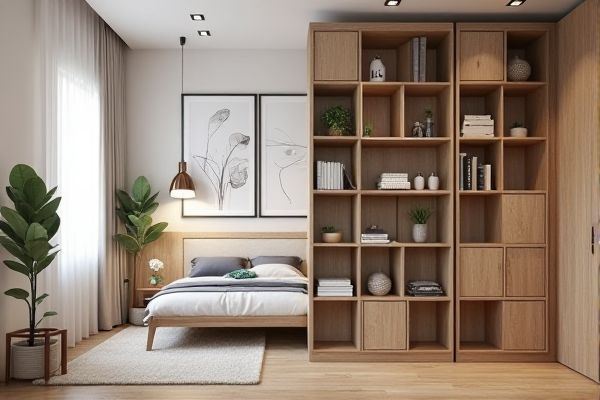
Divider panels offer customizable privacy and organization for open office spaces, while cubby grids provide versatile storage solutions with individual compartments ideal for sorting materials or personal items. Explore the rest of the article to discover which option best suits Your workspace needs.
Table of Comparison
| Feature | Divider Panel | Cubby Grid |
|---|---|---|
| Purpose | Separates content into distinct vertical or horizontal sections | Organizes items into segmented compartments or boxes |
| Design | Thin, linear separators; minimal visual bulk | Grid layout with multiple equally sized compartments |
| Typical Use | Layout structuring and content partitioning | Storage, categorization, icon or widget organization |
| Customization | Simple styling with lines, colors, and thickness | Flexible compartment sizes, shapes, and alignment |
| Visual Impact | Subtle separation; maintains flow | Distinct segmentation emphasizing each compartment |
| Common Context | User interfaces, forms, dashboards | Storage units, UI icon trays, inventory systems |
Introduction to Divider Panels and Cubby Grids
Divider panels provide a flexible solution for creating distinct spaces within an open area, offering sound dampening and privacy without permanent walls. Cubby grids combine storage and organization, featuring multiple compartments designed to hold personal items or office supplies efficiently. Your choice depends on whether you prioritize spatial separation or maximizing storage and accessibility.
Key Features of Divider Panels
Divider panels offer customizable modularity with adjustable heights and widths, providing effective space segmentation in offices or homes. Constructed from sound-absorbing materials, they enhance privacy and reduce noise pollution, improving concentration and productivity. Their sleek design supports cable management options, maintaining a clean and organized workspace.
Key Features of Cubby Grids
Cubby grids offer flexible storage solutions with multiple open compartments, allowing easy organization and quick access to items. Unlike divider panels, cubby grids maximize vertical and horizontal space, making them ideal for classrooms, offices, and homes needing segmented storage. You benefit from improved visibility and accessibility of belongings thanks to their clear, compartmentalized design.
Functionality Comparison: Divider Panel vs Cubby Grid
Divider panels provide flexible space segmentation with a focus on privacy and sound reduction, making them ideal for creating individual work zones in open offices. Cubby grids offer organized storage solutions with accessible compartments, enhancing workspace tidiness and quick item retrieval. Your choice depends on prioritizing either spatial division or efficient storage within your environment.
Space Optimization: Which System Works Best?
Divider panels maximize space optimization by creating individual workstations that enhance privacy and reduce distractions in open office environments. Cubby grids offer versatile storage solutions by combining organization with accessible compartments, ideal for shared spaces requiring collective storage. For tight spaces prioritizing personal work zones, divider panels work best, while cubby grids excel in optimizing storage and accessibility in collaborative settings.
Aesthetic Considerations in Workspace Design
Divider panels create a sleek, modern look by defining individual work zones with clean lines, enhancing privacy and focus. Cubby grids add visual interest and functionality through open storage, fostering an organized and collaborative atmosphere. Choosing between these options depends on your desired balance between aesthetic appeal and workspace utility.
Durability and Material Differences
Divider panels typically use high-density materials such as MDF or plywood with laminate finishes, offering superior durability and resistance to wear and tear. Cubby grids often employ lightweight materials like plastic or metal wire, which may be less durable but provide flexibility and airflow. Choosing the right option depends on your need for long-lasting strength versus lightweight versatility.
Installation and Maintenance Requirements
Divider panels typically require straightforward installation with wall anchors or brackets, making them suitable for quick setups in office or retail environments, while cubby grids demand more precise alignment and assembly due to their modular construction. Maintenance for divider panels generally involves simple surface cleaning and occasional hardware checks, whereas cubby grids may require periodic interior cleaning of individual compartments and inspections to ensure structural integrity. Choosing between these depends on the balance between ease of installation and the complexity of maintaining multiple storage sections.
Cost Analysis: Divider Panel vs Cubby Grid
Divider panels generally offer a lower initial cost compared to cubby grids due to simpler materials and construction. Cubby grids incur higher expenses from increased material use, custom dimensions, and added manufacturing complexity. When evaluating long-term value, divider panels provide cost-effective flexibility for space segmentation, while cubby grids deliver enhanced organization benefits that may justify their higher price point.
Choosing the Right Solution for Your Needs
Choosing between a divider panel and a cubby grid depends on your spatial organization and accessibility needs. Divider panels are ideal for creating distinct work zones or privacy in open areas, enhancing focus and reducing distractions. Cubby grids offer efficient storage and easy access to materials while maintaining an organized visual layout, making them perfect for dynamic environments requiring frequent item retrieval.
 homyna.com
homyna.com